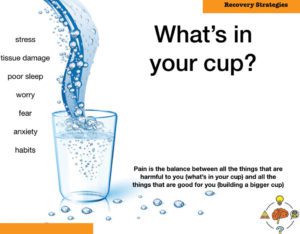By Adam Morris, DC


Back pain is the single most common reason for disability in the United States, which causes people to be unable to work or perform regular activities of daily living. Back pain accounts for roughly 264 million missed days of work per year. That is the equivalent to two full days of missed work for every single full-time worker in the US! The good news is that the vast majority of people with back pain do not have serious conditions such as certain inflammatory conditions, fractures, infections, or cancers. Another bit of good news is that relief from musculoskeletal pain is very common, but there are many people who experience reoccurrence of musculoskeletal pain. With new research emerging from the field of pain science, we now know that pain is much more complex than we originally thought.
The notion that back pain is caused only by tissue damage doesn’t tell the whole story. While tissue damage can cause pain, pain is almost always multifactorial in nature. The biopsychosocial model of pain identifies pain as a unique experience dependent upon the dynamic interaction of biological, psychological, and social factors amongst the person experiencing the pain. It should be the responsibility of the clinician assessing your condition to take into account all of these factors and be careful and concise with the words they say. The point of this article is not to say that all back pain can be resolved conservatively. There are many times when medication and surgery are necessary in the treatment of back pain. The point I want to reiterate is that most musculoskeletal conditions can be managed conservatively, and treatment should focus heavily on patient education, active rehabilitation, self-coping strategies, and assurance.
For example, let’s say you dropped out of high school and have worked construction for the last 25 years. You sustained an injury which caused pain to your low back and you are unable to perform your
job duties. While there may be tissue damage to the area of pain, that is only part of the pain experience. Let’s say you are the head of the household and have children and a spouse to provide for. What are you are going to do if you can’t work construction? How will you provide for your family? How much debt are you in? Do you need to sell your house? These are all anxiety driven questions that can actually exacerbate the feeling of physical pain and affect treatment outcomes.
These questions would be nonexistent if you were a high paid CEO of a Fortune 500 company and experienced a similar back injury. This is an example of how biopsychosocial factors can influence the pain experience and affect treatment outcomes depending on individual factors outside of just tissue damage.
Pain is usually always multifactorial and should be treated as such. The analogy I love to use with patients is the overflowing cup analogy by Dr. Greg Lehman. You can only fill your cup up so much with stress, anxiety, worry, inactivity, lack of/poor movement, poor lifestyle choices etc. before it starts to spill over. The spill over is when an injury occurs, symptoms manifest, and then become comorbid.
There are ways to build a bigger cup such as healthy eating, maintaining good relationships, getting adequate sleep, having a regular exercise program, etc. We are all strong and resilient and can benefit from some education and assurance along the way when it comes to treatment. Next time your cup runneth over, find a clinician that treats the person, not just the symptoms the person presents with. Cheers.
Recharge Wellness Clinic
3521 Bonita Bay Blvd., Bonita Springs, FL 34134
239.776.0155 | RechargeSWFL.com
Sources
1. http://www.greglehman.ca/blog
2. https://www.acatoday.org/Patients/Health-Wellness-
Information/Back-Pain-Facts-and-statistics
3. https://www.practicalpainmanagement.com/treatments/
psychological/biopsychosocial-approach
 Southwest Florida's Health and Wellness Magazine Health and Wellness Articles
Southwest Florida's Health and Wellness Magazine Health and Wellness Articles
